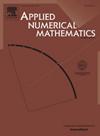非恒定招募率流行病模型的高阶可靠数值方法
IF 2.2
2区 数学
Q1 MATHEMATICS, APPLIED
引用次数: 0
摘要
从数学和生物学角度来看,疾病传播的数学建模都具有重要作用。本文观察了一个具有一般发病率和非恒定招募率函数的 SEIR 型模型。首先,我们观察连续系统的定性特性,然后应用不同的数值方法:一阶和高阶强稳定性保全 Runge-Kutta 方法。我们给出了数值方案保持连续时间解的正向性和有界性的不同条件。然后,通过一些数值实验证明了理论结果。本文章由计算机程序翻译,如有差异,请以英文原文为准。
High-order reliable numerical methods for epidemic models with non-constant recruitment rate
The mathematical modeling of the propagation of diseases has an important role from both mathematical and biological points of view. In this article, we observe an SEIR-type model with a general incidence rate and a non-constant recruitment rate function. First, we observe the qualitative properties of the continuous system and then apply different numerical methods: first-order and higher-order strong stability preserving Runge-Kutta methods. We give different conditions under which the numerical schemes preserve the positivity and the boundedness of the continuous-time solution. Then, the theoretical results are demonstrated by some numerical experiments.
求助全文
通过发布文献求助,成功后即可免费获取论文全文。
去求助
来源期刊

Applied Numerical Mathematics
数学-应用数学
CiteScore
5.60
自引率
7.10%
发文量
225
审稿时长
7.2 months
期刊介绍:
The purpose of the journal is to provide a forum for the publication of high quality research and tutorial papers in computational mathematics. In addition to the traditional issues and problems in numerical analysis, the journal also publishes papers describing relevant applications in such fields as physics, fluid dynamics, engineering and other branches of applied science with a computational mathematics component. The journal strives to be flexible in the type of papers it publishes and their format. Equally desirable are:
(i) Full papers, which should be complete and relatively self-contained original contributions with an introduction that can be understood by the broad computational mathematics community. Both rigorous and heuristic styles are acceptable. Of particular interest are papers about new areas of research, in which other than strictly mathematical arguments may be important in establishing a basis for further developments.
(ii) Tutorial review papers, covering some of the important issues in Numerical Mathematics, Scientific Computing and their Applications. The journal will occasionally publish contributions which are larger than the usual format for regular papers.
(iii) Short notes, which present specific new results and techniques in a brief communication.
 求助内容:
求助内容: 应助结果提醒方式:
应助结果提醒方式:


